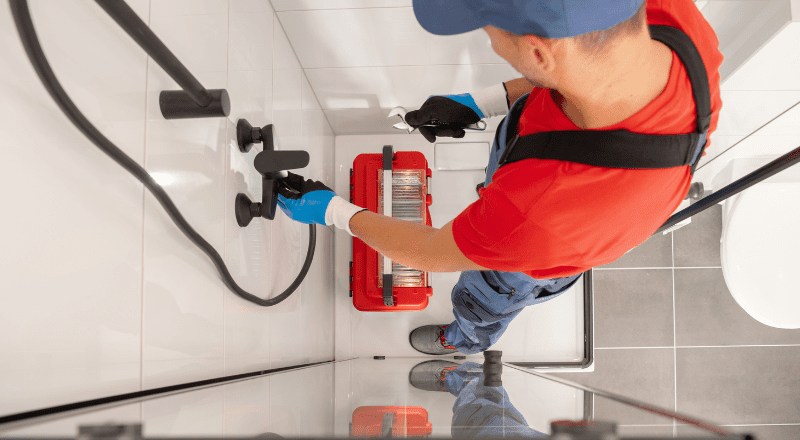Protecting Lives, Property, and the Integrity of Every Job
Plumbing may seem like routine work to the untrained eye, but professionals in the field know it’s anything but simple. Whether it’s working with pressurized systems, cutting through pipes, entering confined spaces, or dealing with sewage lines, plumbing presents a wide range of hazards. This makes safety an essential, non-negotiable priority.
At BORKAT PLUMBING SERVICES, we believe that high-quality work starts with a strong foundation of safety. Below are 10 key safety practices that every plumbing professional—and plumbing company—should follow to ensure the protection of workers, customers, and job sites.
1. Comprehensive Safety Training
Before stepping onto any job site, plumbers should undergo thorough and ongoing safety training. This includes OSHA compliance, equipment handling, hazard identification, and emergency protocols. Training should be refreshed regularly to keep pace with new regulations and technologies.
Tip: Incorporate monthly safety briefings and toolbox talks to keep safety top-of-mind for every team member.
2. Use of Proper Personal Protective Equipment (PPE)
Plumbing professionals should be equipped with the right PPE for each task. This typically includes:
-
Gloves (chemical-resistant, cut-resistant)
-
Safety goggles or face shields
-
Steel-toed boots
-
Hearing protection
-
Respirators or masks (especially in dusty or mold-prone environments)
-
Coveralls or long-sleeved clothing
Wearing the proper PPE is one of the simplest and most effective ways to prevent injury.
3. Lockout/Tagout Procedures
When working on systems that involve water, gas, or electricity, it’s critical to implement lockout/tagout procedures. This ensures that all valves, switches, and power sources are securely shut off and labeled to prevent accidental activation while work is in progress.
Neglecting lockout/tagout can lead to life-threatening accidents, such as unexpected water surges or electrical shock.
4. Proper Handling of Hazardous Materials
Plumbers often work with substances that can be hazardous, such as adhesives, solvents, and even sewage. Professionals must know how to:
-
Read and follow SDS (Safety Data Sheets)
-
Store and dispose of chemicals properly
-
Avoid direct skin or eye contact with contaminants
-
Follow proper decontamination procedures after exposure
5. Safe Use of Tools and Equipment
From pipe cutters and threading machines to power tools and hydro jetters, every piece of equipment comes with risk. Plumbing professionals should be trained on the safe operation of all tools and inspect them regularly for signs of damage or malfunction.
Using damaged tools is not only unsafe but can compromise the quality of the job.
6. Confined Space Awareness
Confined spaces—such as crawlspaces, basements, and underground vaults—pose unique risks. These include poor ventilation, gas exposure, and restricted movement. Before entry:
-
Test the atmosphere for oxygen levels and harmful gases
-
Ensure proper ventilation
-
Use communication devices or spotters
-
Follow entry/exit procedures
In confined spaces, having a rescue plan is just as important as having the right equipment.
7. Ladder and Fall Safety
Many plumbing tasks involve climbing ladders, entering attics, or working from elevated platforms. To minimize fall hazards:
-
Always use a ladder rated for the job
-
Set ladders on stable, level ground
-
Maintain 3-point contact (two hands and one foot)
-
Wear fall protection when working above six feet
8. Situational Awareness on the Job Site
Every job site is different, and situational awareness is key to staying safe. Plumbers should always:
-
Be alert to changing conditions
-
Communicate clearly with other workers
-
Look out for tripping hazards, exposed wiring, and pressurized systems
-
Understand the site layout before starting work
9. Hydration and Heat/Cold Stress Management
Plumbing work often takes place outdoors or in unconditioned spaces. Extreme temperatures can lead to heat exhaustion, dehydration, or cold-related injuries. Professionals must:
-
Stay hydrated, especially in hot climates
-
Take breaks in shaded or heated areas
-
Dress appropriately for the weather
-
Recognize the symptoms of heat or cold stress early
10. Reporting and Documenting Hazards
A culture of safety only exists when employees are encouraged and empowered to report hazards without fear of penalty. All incidents, near misses, or unsafe conditions should be documented and investigated to prevent recurrence.
A safe workplace is a communicative one. Encourage feedback and participation in safety improvement efforts.


